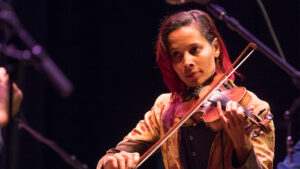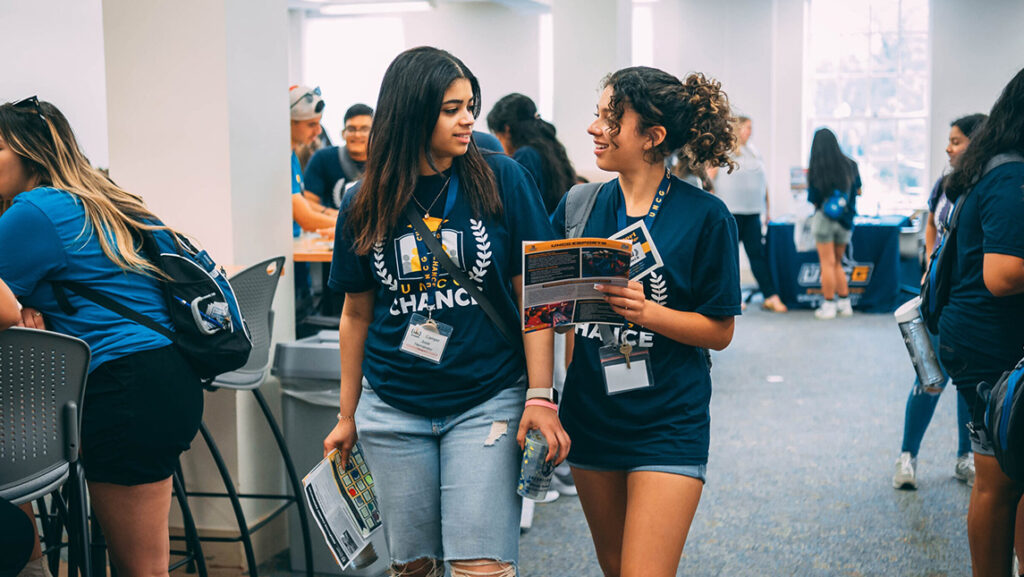David Aarons recently came up with the idea to have some of his students make their own musical instruments.
“Imagine the government has just banned your drums,” the assistant professor in the School of Music and faculty affiliate of African American & African Diaspora Studies tells them. “So, how can we make a composition with bamboo?”
He tells them about the enslaved Africans in 19th-century Trinidad when the government deemed their African drums a nuisance or an incitement to rebellion. Afro-Trinidadians then made new percussive instruments out of bamboo.
They incorporated other materials over the years, including oil drums, leading to the creation of the steelpan. Its bouncy, harmonic tones, created by striking mallets against the dents in the drum, are among one of the most recognizable sounds among percussive instruments.
Aarons was born in Jamaica. He studied the steelpan there and in Trinidad and Tobago before he joined UNC Greensboro’s College of Visual and Performing Arts. He started the School of Music’s steelpan ensemble course.
As an ethnomusicologist, Aarons focuses on music’s role in culture. He and his students use music as a lens to see how cultures move, adapt, and interact over time. Students discover how Black music connects to parts of the world they may not expect, through eras of celebration and hardship.
Musical movements
June is Black Music Month. In his proclamation, President Joe Biden said it celebrates “Black artists who have used their songs to stand up to injustice, fight for equality, and reflect a mirror on society – reminding us all of our enduring obligation to deliver the promise of America for all Americans.”
The first Black Music Month was declared by President Jimmy Carter in 1979. That year, Donna Summer, Chic, the Village People, Anita Ward, and Peaches and Herb topped the music charts.
Aarons says there’s a lot to unpack when defining Black music. Listing musicians is straightforward but studying a genre’s history does not come with a clear timeline.
Record labels began to make distinctions in the 1920s between “Black music” (Race Records, later known as R&B) and “White music” (country). Musicians and even instruments were forced into these new labels.
For example, Aarons says many people don’t know the banjo’s origins can be traced through the Caribbean back to West Africa. “That’s because the banjo became associated with country and old-time music. And people don’t know that African Americans were fiddling in the 1800s.”
“Music moves because people move. It’s hard to know when people started to play a type of music in an area. There’s a lot we don’t know, so we look at what we can know based on the evidence that exists.”
“The Caribbean is connected to everything,” he explains. Reggaetón, one of his favorite styles, was influenced by Jamaicans building the Panama Canal, and then by Panamanians and Puerto Ricans who moved to New York. Jazz musicians frequently traveled between Cuba, Mexico, and New Orleans, and some scholars noted similarities between early jazz and the Afro-Cuban orchestral style of danzón.
He poses those questions to his students in his American music class: “To what extent did musicians from those countries influence early jazz at the turn of the 20th century? It’s hard to know definitively.”
Critically listening
Aarons tells his students to “embrace the messiness” as they comb through historical evidence.
“I try to emphasize that Blackness is not a monolith. Music can be used to show the complexity of Blackness and Black identity.”
He does not center his classes around specific artists, because he does not want students to create a distinction between “important” and “unimportant” musicians. Instead, he gives them the tools for critical listening, to analyze and contextualize their music.
“It’s connecting the ‘social’ to the ‘sonic,'” he says. “How is what we’re hearing connected to politics, religion, gender norms, gender identity, sexuality, and race relations at the time? How is it contesting some of these assumptions? How is it reinforcing some of these entrenched positions on what it means to be a man or a woman, or in a relationship?”
They look at the lyrics, the choice of instruments, and the artists’ performances. “Who is able to represent themselves onstage, in a music video, or on a record? How much agency do those people have? We look at a few examples of that.”
Black music in North Carolina

During Black History Month in 2019, Governor Roy Cooper hosted a reception honoring dozens of artists from North Carolina. The honorees represented many areas of music: Broadway performer and High Point native Fantasia Barrino, Gospel singer Sister Lena Mae Perry, the late fiddler Joe Thompson, and Grammy Award-winner Rhiannon Giddens.
“Giddens has reignited this revival of Black banjo traditions, old-time music, and the fiddle as well,” says Aarons.
One of Aarons’ favorite musical traditions, Junkanoo, is also seeing a revival in North Carolina.
“It’s a big masquerade festival I grew up with in Jamaica. It comes out of West African traditions. It also exists in the Bahamas, Belize, Honduras, and it used to exist in North Carolina for a long time. There is evidence of it in Wilmington and other coastal regions. Then it disappeared. People don’t know why. They are reviving it now.”
Despite its connection to slavery in the Americas, Junkanoo is a festive occasion.
“Enslaved Africans were only allowed to hold it during Christmastime. It marks a celebration. It even mocks the colonizers. It provides a little pushback, a little agency.”
That power of music within culture is what interests Aarons and his students as they journey through history. The roadmap may not always be clear, and some of the stops are difficult to explore, but it helps them appreciate Black music’s worldwide influence.
The history of the steelpan is a perfect example.
“The music is fun to play. It does evoke this idea of the island. It also comes with baggage. But we can’t only focus on pain and trauma. There’s joy, there’s celebration, there’s hope.”
Story by Janet Imrick, University Communications
Photography by Martin W. Kane and courtesy of David Aarons



